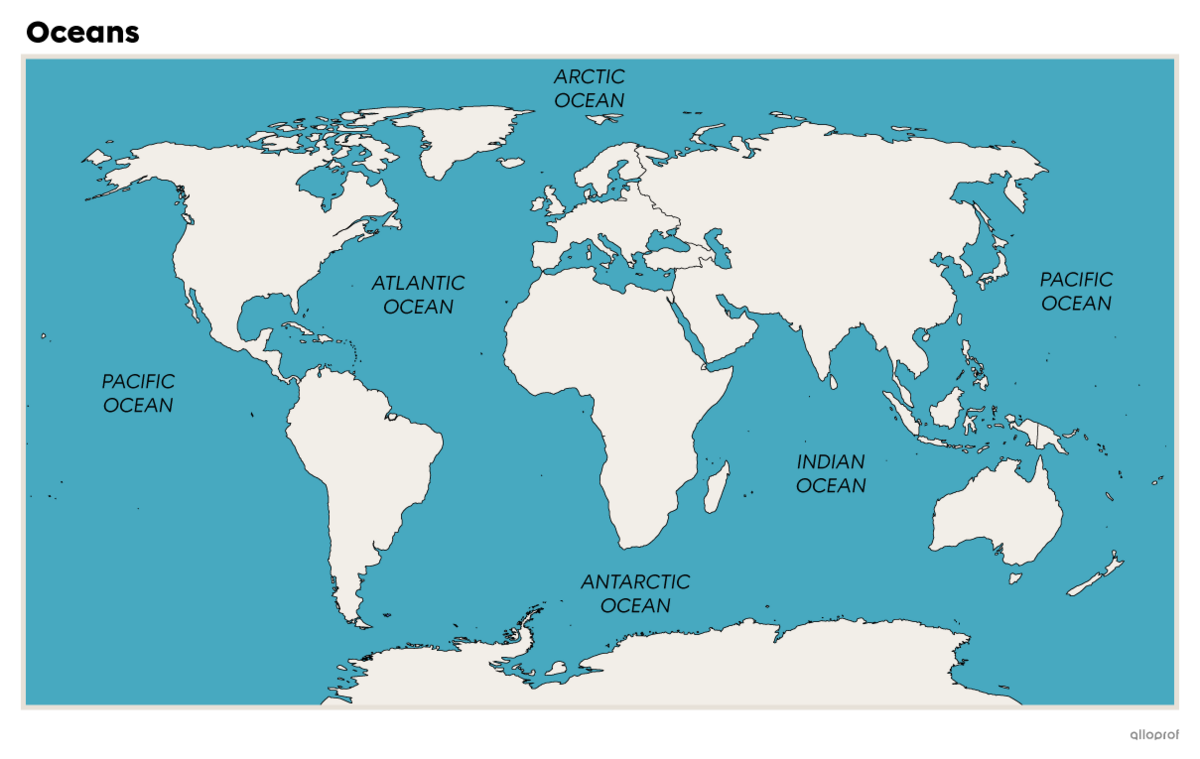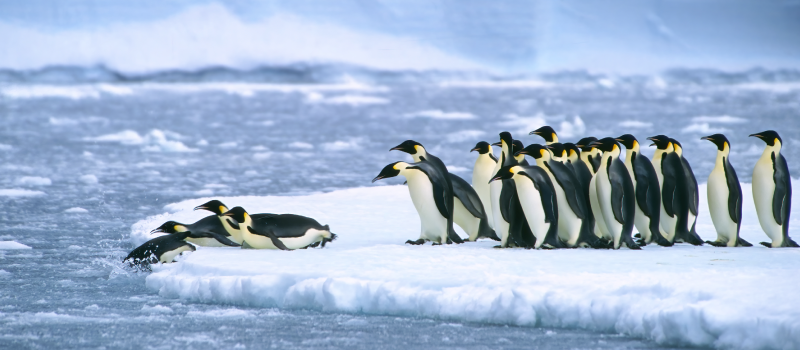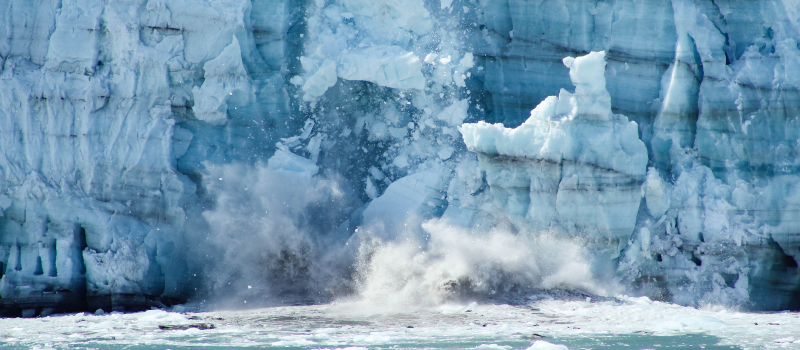To access the rest of the unit, consult the Tools in Geography concept sheet.
The Earth's total surface area is 510 million km2: the continents cover 149 million km2, while the oceans cover 361 million km2. This means 71% of the planet is covered by water. This is one of the reasons the Earth is nicknamed “the blue planet”[1].
An ocean is an immense expanse of salt water located between two continents.
The Earth is covered by an immense ocean, known as the “world ocean” or “global ocean.” In fact, although there are 5 major oceans, they actually form just one vast world ocean, since they are all connected to each other.

The Earth's five oceans are the Pacific, Atlantic, Indian, Antarctic and Arctic. The boundaries separating each of these oceans mostly correspond to the continents. In the case of the Antarctic Ocean, it is the latitude 60° S that separates it from the Pacific, Atlantic and Indian Oceans[2].
The Pacific Ocean is the largest ocean, with a surface area of about 181 million km2 [3]. It accounts for more than half the total surface area of the oceans and more than a third of the total surface area of the planet.
The average depth of the oceans is around 3940 m[3]. The deepest place on the planet is in the Pacific Ocean, east of Japan and the Philippines. The ‘Challenger Deep’ is located in the Mariana Trench and reaches depths of about 10 925 m[10].
The Pacific Ocean owes its name to the navigator Fernand de Magellan, who is credited with the first circumnavigation of the globe by ship. The explorer is said to have given it the name Pacific in 1520 because of the very calm waters on which he sailed.
The Atlantic Ocean is the second largest ocean on the planet, with a surface area of over 82 million km2. It lies between the continent of America (to the west) and the continents of Europe and Africa (to the east). Its average depth is 4000 m[4] and its deepest point is in the Puerto Rico Trench, at 8376 m below sea level[10]. One of the Atlantic's special features is that more than half of the planet's freshwater flows into it.
The Indian Ocean is located between Africa, Asia, Antarctica and Australia and has a surface area of around 70 million km2. Its average depth is 3741 m, and the deepest point is over 7450 m down, in the Java Trench, located south of the island of Java in Indonesia[5]. The Indian Ocean is different from the other oceans because it doesn't extend to the colder waters of the poles. As a result, it has a more tropical temperature when compared to the other oceans.
The Antarctic Ocean, also called the Southern Ocean, surrounds the continent of Antarctica at the planet's South Pole and has a surface area of around 21 million km2[6]. Some scientists consider this ocean to be the heart of the world ocean, as it lies to the south of the Pacific, Atlantic and Indian Oceans. What's more, the deep waters of the Antarctic Ocean are one of the main drivers of ocean currents. The deepest point in this ocean lies in the South Sandwich Trench at 7434 m[10] below sea level.
The Antarctic Ocean boasts a great diversity of animal and plant species. In fact, there are several hundred endemic species in this region, including whales, penguins and seals.
The term endemic refers to an animal or plant species that lives in a delimited territory.

The emperor penguin is endemic to the Antarctic Ocean and the continent of Antarctica. It's a flightless seabird that looks a lot like a penguin, only bigger.
Source : Jivko Konstantinov, Shutterstock.com
The Arctic Ocean is the smallest of the five oceans, with a surface area of around 12 million km2[7]. The shores of the Arctic Ocean can be found in five countries: the United States (in Alaska), Canada (in Nunavut, among others), Denmark (in Greenland), Norway and Russia. The deepest point in the Arctic Ocean is the ‘Molloy Deep’, also known as the ‘Molloy Hole’, located at a depth of 5550 m[10].
The North Pole, covered by ice caps, lies at the centre of the Arctic Ocean.
Some of the impacts of climate change can be seen in the Arctic region, which is seeing its ice disappear a little more each year. In 1989, the Arctic pack ice had an area of around 3 million km2. In 2019, its area was just 250 000 km2[8]. Several simulations predict the complete disappearance of Arctic ice sometime around the summer of 2070[7].
Over the past 20 years, more than 28 000 tonnes of ice have disappeared, with numerous consequences such as:
-
several animal species are losing their habitat
-
ocean currents are being altered
-
sea levels are rising, causing flooding in many parts of the world, as well as causing many islands[9] to disappear altogether
For more information, please consult the following concept sheets.
To access the rest of the unit, consult the Tools in Geography concept sheet.
1. Bergevin, R., Charette, J. et Méthé, M. (2014). GÉO à la carte - Cartes et croquis - 1er cycle du secondaire [Cahier d’activités]. CEC.
2. Cenedese. C. (2021, July 8th). Ocean. Encyclopedia Britannica. https://www.britannica.com/science/ocean
3. Francheteau, J. (n.d.). Pacifique océan. Encyclopédie Universalis. https://www.universalis.fr/encyclopedie/ocean-pacifique/
4. Pinot, J.-P. (n.d.). Atlantique océan. Encyclopédie Universalis. https://www.universalis.fr/encyclopedie/ocean-atlantique/
5. Kanayev, V. F., Verlaan, P. A., Morgan, J. R. (2021, December 13th). Indian Ocean. Encyclopedia Britannica. https://www.britannica.com/place/Indian-Ocean
6. Cenedese. C. (2021, July 8th). Major subdivisions of the oceans. Encyclopedia Britannica. https://www.britannica.com/science/ocean/Major-subdivisions-of-the-oceans
7. Kandel, R., Pinot, J.-P. (n.d.). Arctique océan. Encyclopédie Universalis. https://www.universalis.fr/encyclopedie/ocean-arctique/
8. Radio-Canada. (2021, January 27th). La fonte de l’Arctique, un phénomène inquiétant et très bien documenté. https://ici.radio-canada.ca/ohdio/premiere/emissions/moteur-de-recherche/segments/chronique/340822/rechauffement-planete-banquise-urgence-climatique
9. Conservation nature. (n.d.). Fonte des glaces: définition, causes et conséquences. https://www.conservation-nature.fr/ecologie/la-fonte-des-glaces/#Les_consequences_de_la_fonte_des_glaces
10. The Five Deeps Expedition. (n.d.). Expedition. https://fivedeeps.com/home/expedition/atlantic/




